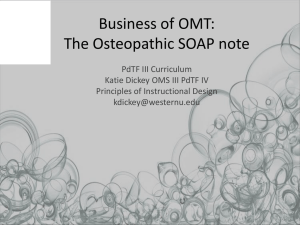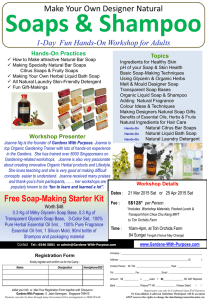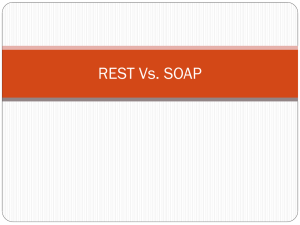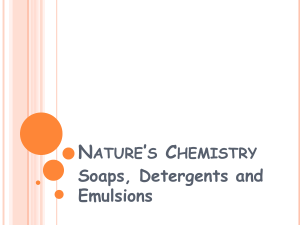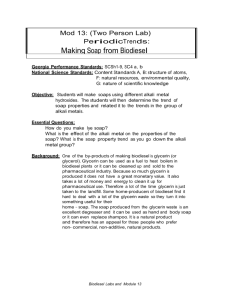Preparation and Properties of a Soap
advertisement
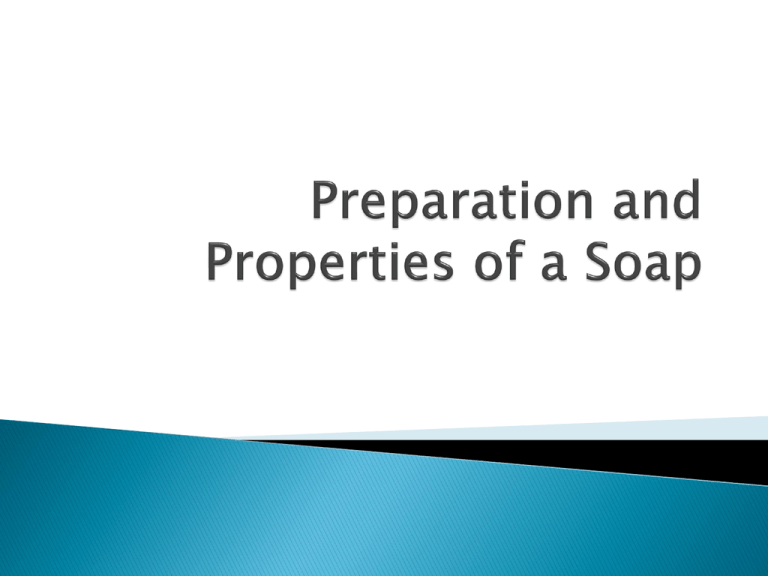
Soap is the sodium or potassium salt of a longchain fatty acid. Sodium Stearate Because “like dissolves like” the nonpolar end of the soap molecule can dissolve the greasy dirt, and the polar or ionic end of the molecule is attracted to water molecules. An emulsifying agent is a substance used to disperse one liquid in the form of finely suspended particles or droplets in another liquid. This is what soap is… Sketch courtesy of: http://www.chromatography.amershambiosciences.com/ When we treat fats or oils with strong bases such as lye (NaOH) or potash (KOH) they undergo hydrolysis and form glycerol and soap. Because soaps are salts of strong bases and weak acids, they should be weakly basic. However, sometimes soap can be basic enough to cause skin damage so an alkalinity test must be performed on our soap after we make it today. Soap becomes ineffective in hard water. Hard water contains large amounts of Ca2+ and Mg2+ salts. Because of this, synthetic detergents have become common alternatives for soap. In acidic solution, soap is converted to free fatty acid and therefore loses its cleansing action. Use vegetable oil to make soap. Use alcohol as a solvent and NaOH to hydrolyze the fatty acid into our soap compound. Filter our soap. Test the properties of soap… Emulsifying properties: we will mix oil and water and see how the addition of our soap effects the mixture’s ability to form an emulsion. Hard water reactions: we will test our soap with minerals associated with hard water to demonstrate their effects on our soap. Alkalinity - we will test the basicity of our soap. Alcohol is flammable! Do not allow near an open flame or heat source. Do not take your soap home for personal use!! Inhalation: irritant, coughing, shortness of breath, drowsiness, loss of appetite, aspiration pneumonia, chemical pneumonitis, pulmonary edema, coma Ingestion: irritation of the mucous membranes, mouth, throat and digestive tract, gastrointestinal upset, vomiting, abdominal pain, vomiting, diarrhea, central nervous system depression, hypocalcemia, lack of reflexis, headache, gastritis, intoxication, blindness, low blood pressure, tachycardia, skin discoloration, rigidity, convulsion, dehydration, organ congestion, perforation, shock, coma, death Skin contact: irritant, burns, cracking, flaking, defatting of skin, absorption through the skin, dermatitis, ulcers, rash, cyanosis Eye contact: mechanical abrasion of the eyes, tearing, burns, pain, blurred vision, conjunctivitis, corneal damage Tumorigen, mutagen, teratogen and reproductive effector


